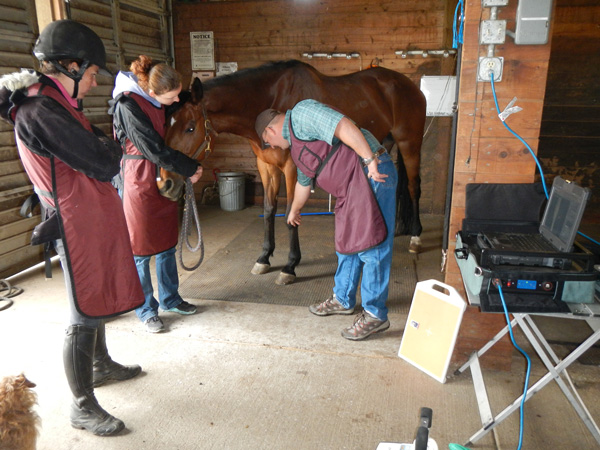The obvious goal of expanding your practice’s services is income, but when done well, providing something new for your clients yields a lot more than dollars. This is what Chris Wickliffe, DVM, owner of Cascadia Equine Veterinary Clinic, in Corvallis, Oregon, confirmed when he upgraded his digital X-ray and ultrasound offerings over the past two years.

“In terms of my practice, offering this level of service is bringing in new clients,” Wickliffe said. “Personally, moving my diagnostics to a higher level has significantly increased my own work satisfaction and enjoyment.”
But jumping head-first into a new service is a terrible idea if you haven’t done your homework. At Equine Sports Medicine & Surgery (ESMS) in Weatherford, Texas, CEO Kirk Eddleman, MHA, and the staff make decisions as a team. “Before we add a new service for ESMS, we do a feasibility study to see if adding a new service warrants the investment of time, money and energy,” he said.
In 2012, the group added advanced podiatry to the practice’s service roster. “We knew there was a void for advanced podiatry services in our area and recruited a veterinarian with those skills and interests,” he explained.
Eddleman said it wasn’t as simple as finding a new associate to bring on board. “The first question we must answer is: ‘Does the new service fit our practice’s mission?’ If so, we put together a group of staff members, managers, associates and owners to discuss the reasons we want the new service, and perform a break-even analysis that includes the potential costs, expected volume and, most importantly, the projected profitability. We also discuss logistics of implementation, like marketing, training, pricing, etc.”
According to John Nolan, DVM, founder of The Piedmont Equine Clinic in The Plains, Virginia, “The two overriding factors [when considering a new service] are innovation and client demand.”
His best example of pairing these two factors is the practice’s brick-and-mortar clinic, built in 2005. “We started back in the ’90s as an ambulatory practice, and over the years, clients have wanted to retain their advanced critical care and electoral surgeries within the practice,” explained Nolan.
Upon building The Piedmont Equine Clinic, the practice brought specialists on board and watched the business grow.
Wickliffe said client demand is among the top considerations for adding a service. He recognizes that his client base is highly educated and requests a certain level of service, so he looks at whether the new service will allow him to continue to develop this client base and create a more bonded client, as well as whether clients will balk at the higher costs warranted to pay for the new technology.
He also looks at the addition’s effect on him as a solo practitioner. He knows it is important that he remain involved and excited about his job and be reasonable about the amount of continuing education and time he spends away from his practice. He also wants to seek out services that will make his job less difficult.
Crunching Numbers
Even when criteria are pushing you toward a new service, your practice’s financial situation needs to take top billing in any decision.
“Sometimes there’s loss in the beginning,” Nolan said, but he uses a four-year calculation to justify new services.
Estimate the number of cases you can expect to see in that period, estimate the cost you will charge your clients based on staff time and equipment investment, and calculate the total possible revenue production over that period.
The Piedmont Equine Clinic has been considering adding an MRI for the past several years, but after looking at the number of cases they’ve referred elsewhere versus the cost of the machine, it hasn’t yet made financial sense. On the other hand, the practice tracked the number of cases they referred to other hospitals in the years leading up to their clinic-building project, and those numbers made sense. In addition to having peace of mind that the clinic would succeed financially, “We had a fairly large body of data to present to the bank when asking for a loan,” Nolan said.

Not Just About the Money

“Both [the X-ray and ultrasound upgrades] allow me to visualize other areas of the horse that the prior ultrasound and X-ray could not do,” said Wickliffe. “It allows me to be able to do more at the time of service, which is extremely important in a 100% ambulatory practice. I can do real-time diagnostics and treatments. This increases my clients’ trust since I can give them better and more dependable answers, bonding these clients to my practice.
“Previously, I would have had to send certain clients to a referring veterinarian for further diagnosis,” said Wickliffe. “Now I can market these new diagnostic tools to my current clientele who, in turn, market to prospective clients.”
Strategic Veterinary Consulting principle Jim Guenther, DVM, MBA, MHA, CVPM, said when vets or clinics add a new service, “They may discover a new set of clients. Maybe they have hired a new DVM who has expertise in sport horses. By finding a new or untapped client base, they may create more opportunities to generate additional revenue for the practice with already-existing services.”
Take-Home Message
Whether you’re eyeing an advanced digital X-ray or are considering the addition of a specialized practitioner, “Analyze the opportunity to see if it will fit for you and your practice,” advised Guenther. “Be realistic and remind yourself not all of the opportunities are worthy of your time and money to develop.”
About the author: Freelance writer Lisa Munniksma has temporarily traded in horse ownership for a mission to learn about sustainable living, agriculture and food systems. Follow her round-the-world travels at www.freelancefarmerchick.com.
SIDEBAR
SAVE Marketing Tips
Having a new service won’t do your practice (or your clients) any good if no one knows about it. Here are tips from veterinarians about their top marketing strategies for introducing new services.
“Consider completing the set-up and practice time for your new service in a ‘safe’ but public environment, allowing clients to be part of this experience,” said Chris Wickliffe, DVM, of Cascadia Equine Veterinary Practice. “When I first got the [new digital X-ray and ultrasound equipment], I did my set-up and practice time at several large barns to learn how to use the equipment, but also to show the capability of the equipment to clients.”
Kirk Eddleman, MHA, of Equine Sports Medicine & Surgery, said, “Market it using social media, flyers, website, etc. Do everything you can to get the word out.”
Jim Guenther, DVM, MBA, MHA, CVPM, of Strategic Veterinary Consulting, said to think of the acronym SAVE.
S is for Solution—define the problems they solve; don’t focus on features, functions or technological superiority.
A is for Access—develop an integrated cross-channel presence.
V is for Value—articulate the benefits relative to the price.
E is for Education—provide information relevant to customers’ specific needs.
Client education seminars are a top marketing tool for The Piedmont Equine Practice. Jim Nolan, DVM, said 75-100 people attend each event with topics highlighting what’s new in the practice in the form of education. The practice uses email, Facebook and website notifications to spread the word, keeping its name in front of current and prospective clients.—Lisa Munniksma








